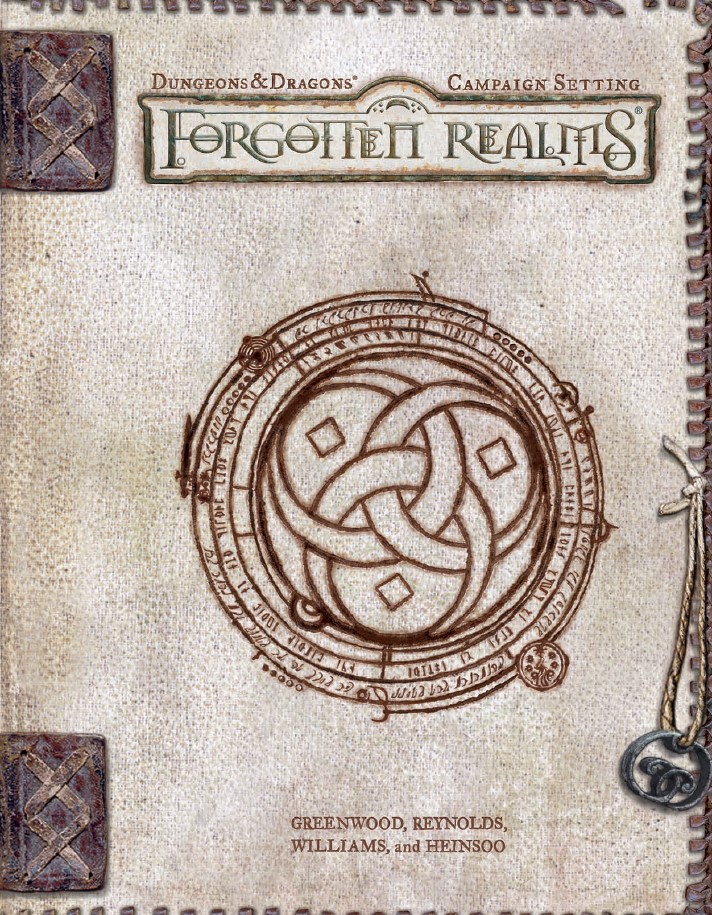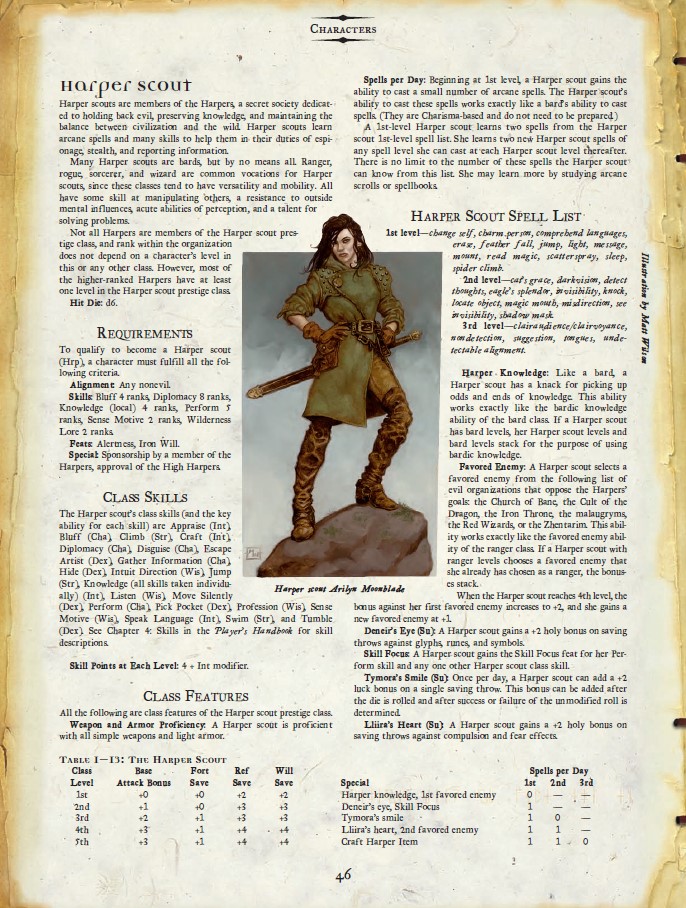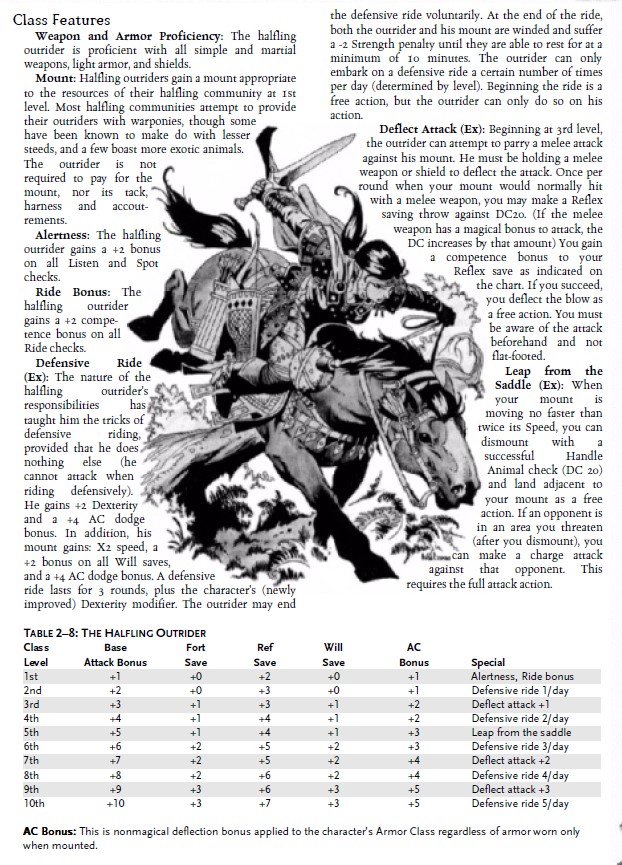
One of the areas in Dungeons & Dragons 3e that are sorely misunderstood and misused are Prestige Classes – even in the official books!
They were created for use by the GM as a worldbuilding tool, not to fill up splat books.
The issue with the published prestige classes is that they were designed to be too general (except for some of the racial ones), which is the antithesis of what they were supposed to be – that is, specific to the individual GM’s campaign world.
In fact, their misuse leads many people to see prestige classes in Dungeons & Dragons 3rd edition and say that they are a poorly conceived design concept, and that they don’t work as intended.
This is no surprise, given the misuse!
All this comes directly from Monte Cook – one of the core designers of D&D 3.0 – on his blog back in September 2001:
The original design intention behind them [prestige classes] was to allow DMs to create campaign-specific, exclusive roles and positions as classes. These special roles offer abilities and powers otherwise inaccessible to PCs and focus characters in specific, interesting directions.
He goes on to clarify this by stating the following:
The key there — the one that’s now often missing — is that these are supposed to be DM-created tools, to lend specificity and actual mechanics to the details of your world. In short, you [the DM] come up with some group, role, or whatever for your campaign (the Rangers of the Northwood, the Thief’s Guild of Bandonburg, the Nightstalkers, etc.), and you create a prestige class based around that group. [Bolding by me].
In part two of this 2-part post, Monte goes on to say “There are four basic reasons why you should create prestige classes for your campaign:”
-
-
- To Develop an Organization
- To Develop a Race or Culture
- To Satisfy Players
- To Make Otherwise Poor Options Acceptable
-
Of these four, the first two are (in my mind) the most important for worldbuilding.
Prestige Classes as Worldbuilding Tools
There are a number of ways you can use prestige classes to help with worldbuilding, but before they can be a great help, you really need to have a list of factions, organisations, and governments for your campaign world.
This way, you can use prestige classes as rules (if you are playing 3rd edition), or added flavour (if you are playing other D&D rulesets) to backup and reinforce your campaign world.
Check out an article by Andy Collins called Campaigning with Class (p.66) in Dragon issue 293 on how to do this.
The most obvious way is to create some prestige classes based on your factions and organisations. This is especially helpful if you are playing 3rd edition.
But even if you are not playing this edition of D&D, you can still either partially create some prestige classes, or look through some of the 3rd edition books (most have a list of various prestige classes) and use their name and description, if not the actual rules.
For example, in the 3rd edition Dungeon Master’s Guide there is a prestige class called Arcane Archer. This is a prestige class specifically for elves.
You could take this class as is, and apply it to all elves, or you could have it only apply to elves from Drakenwood, calling it “Drakenwood Archer”.
Then, if you are playing another edition or hack (other than 3rd ed) you can use the flavour text and abilities and craft the Drakenwood Archer for the rules you are using (or just keep it to the flavour text).
You now know a lot more about those who live in the Drakenwood, and can relay this information to your players via rumours, sages, or their own knowledge.
The Forgotten Realms Campaign Setting book for 3rd edition (which is one of my all-time favourite D&D books) has some great prestige classes you can use or get inspiration from.

It contains a number of Forgotten Realms-specific prestige classes that can only be found there: a Harper Scout, the Purple Dragon Knight, and the Red Wizard to name but three.

An Example
In my campaign world there is a forest called Torchwood and it is inhabited by Torchwood elves, who tend to be rather isolationist. To keep invaders or curious folk away, the elves have developed expert riders whose mounts are stags.
These stag-riders are known locally as Torch Riders.
To represent these riders with rules for D&D 3e I used the prestige class from the Sword & Fist sourcebook for 3.0, Halfling Outrider.

Halfling Outriders are great in the saddle, having bonus to their armour class and ride abilities, plus being able to protect their mount from taking damage.
All I need to do is change the name from Halfling Outrider (a little too generic, any way) to Torch Rider. Then I can add some flavour text about how these elven Torch Riders patrol the Torchwood and surrounding plains, looking for threats against the forest and the elven people and animals who live there.
Beneath the canopy of the Torchwood the Torch Riders patrol tirelessly. These elven guardians, mounted on their stag mounts, glide through the forest with grace. Each rider bears an elven spear created by the elves’ ancient forebears.
Beyond the forest’s borders, the Torch Riders range across the surrounding plains. Their keen eyes scan the horizon for signs of danger – roving bands of raiders, creeping monstrosities, or the machinations of those who would despoil the elven lands. No movement escapes their notice; no predator stalks unseen. They are swift and unyielding, as much a part of the forest as the trees themselves.
Finally, I just need to change the prerequisites.
Originally they were:
Base Attack Bonus: +5
Race: Halfling
Listen: 4 ranks
Ride: 6 ranks
Spot: 4 ranks
Feats: Mounted Combat, Mounted Archery
And I changed them to:
Base Attack Bonus: +5
Race: Torchwood Elf
Handle Animal: 4 ranks
Listen: 4 ranks
Ride: 6 ranks
Spot: 4 ranks
Feats: Mounted Combat
I made the race Torchwood Elves only, and I dropped the Mounted Archery as there is no real correlation between that feat and the prestige class. I also added the Handle Animal skill.
If you wanted to ignore the rules (because you don’t use them), simply keep the flavour text and the prerequisites of being a Torchwood Elf, and being able to ride and fight.
For 2nd edition D&D, or using my Kits from Issue 32 of d12 Monthly for Old School Essentials, you could translate this 3e prestige class into a kit.
Torch Rider Kit
Description
Beneath the canopy of the Torchwood the Torch Riders patrol tirelessly. These elven guardians, mounted on their stag mounts, glide through the forest with grace. Each rider bears an elven spear created by the elves’ ancient forebears.
Beyond the forest’s borders, the Torch Riders range across the surrounding plains. Their keen eyes scan the horizon for signs of danger – roving bands of raiders, creeping monstrosities, or the machinations of those who would despoil the elven lands. No movement escapes their notice; no predator stalks unseen. They are swift and unyielding, as much a part of the forest as the trees themselves.
Requirements
To qualify to be a Torch Rider, the character must be an elf from Torchwood, and be able to ride and fight from a land-based mount. In addition, they must also have a Dexterity score of 12 or greater.
Role
Torch Riders protect their people and their mounts from outside threats. This could be direct threats (attacks on the forest) or more insidious threats that means that the Torch Rider would need to explore further afield.
Secondary Skills
Torch Riders tend to have the following secondary skills: Animal Trainer, Huntsman, and Outrider. (This uses my streamlined secondary skill system for Old School Essentials and B/X in Issue 32 of d12 Monthly).
Equipment
A Torch Rider carries an ancestral spear (this is a masterwork item that gives +1 to hit) and rides a stag steed, which has been trained for battle (similar to a warhorse).
Special Benefits
Torch Riders are very perceptive to dangers and are only surprised on a 1 on a D6.
Additionally, they gain a +1 bonus to any manoeuvres or attacks while mounted. Torch Riders can also protect their stag mount from attacks, giving it a +2 AC bonus when the rider is mounted.
Special Hindrances
Torch Riders come from a society that is xenophobic and distrusts outsiders, suspecting them of plotting against the elves and Torchwood. This translates into a -2 penalty to all reaction rolls a Torch Rider makes.
They are also less capable in combat on foot, and are considered slow for initiative no matter what weapon they are using.
This is now done.
But even without the addition of any rules, the favour text alone can add so much depth to these Torch Riders, in particular, and the Torchwood elves, in general.
Over to You
Have you ever used prestige classes in this way? Do you find it helpful?
While You’re Here…
Since 2021 I have been publishing d12 Monthly, a monthly zine, which has a ton of articles for any edition of Dungeons and Dragons.
Printed copies are available in my store. The PDF is available on DriveThruRPG and you can get both, plus support my work, via my Patreon.
I will also be releasing some more products in the near future.
Feel free to reach out to me on Twitter or my contact page any time.

Love the idea of these Elves. And how using old systems, adapting them and making something new.
Thanks, Alex. Me too. One thing about 50 years of D&D is that you can pull stuff from any edition and make something new out of it.